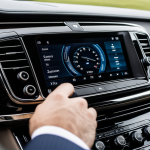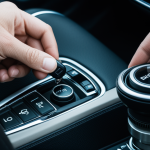Understanding Your Car’s Headliner
The car headliner is more than just an interior trim piece; it plays a key role in comfort and safety. Fundamentally, a headliner consists of a fabric covering bonded to a foam backing attached to a sturdy substrate like fiberglass or plastic. This layered construction ensures durability and noise insulation, while providing a smooth aesthetic finish to the ceiling of your vehicle.
Beyond aesthetics, the headliner contributes to sound absorption, vibration dampening, and thermal insulation, enhancing the driving experience. Modern materials like polyurethane foam and fabric blends improve these functions and resist sagging over time.
Have you seen this : Mastering Your Ride: Expert Tips to Perfectly Tune the Suspension on Your Ducati Hypermotard 939
Signs of wear or early deterioration include visible sagging, discoloration, and a loose, detached fabric. Early sagging often feels spongy to touch and may emit a musty odor, indicating collapsing foam backing. Recognizing these symptoms is crucial for timely headliner maintenance. Proper care not only preserves appearance but also prevents costly repairs later. Regular inspection can help spot subtle changes and extend the life of your headliner, ensuring continued comfort and style inside your vehicle.
Common Causes of Headliner Sagging
Sagging headliner occurs when the fabric detaches from its foam backing, creating a loose, drooping ceiling surface. One primary cause of a sagging headliner is prolonged exposure to humidity and moisture, which breaks down the adhesive bond holding the layers together. High heat and UV exposure also accelerate foam deterioration and weaken the glue, making the fabric more prone to sagging.
Also to see : Navigate UK Traffic Rules: The Role of Dashboard Cameras in Boosting Road Safety
Improper cleaning techniques or the use of harsh chemicals can damage the delicate materials in the headliner, leading to headliner problems like premature sagging. Physical stress, such as pressure from heavy items or rough handling, further contributes to adhesive failure and fabric distortion.
Natural aging is another common factor. Over time, the foam backing loses its structure, adhesives dry out, and the fabric starts to pull away. This combination of environmental, mechanical, and age-related factors explains many typical causes of sagging. Understanding these elements helps highlight why prompt headliner maintenance and careful care are essential to avoid costly repairs or complete replacement.
Cleaning Techniques for Preserving Headliners
Maintaining your car headliner through proper cleaning is key to extending its life and preventing sagging. The best cleaning methods focus on gentle care to avoid damage to the delicate fabric and foam layers. For spot-cleaning, use a soft microfiber cloth dampened with a mild upholstery cleaner or a mixture of water and gentle soap. Avoid soaking the headliner, as excessive moisture can weaken adhesives and lead to early sagging.
When handling full-surface cleaning, lightly mist the cleaner and gently blot instead of scrubbing to maintain the foam’s integrity. Specialized foam cleaners designed for automotive interiors are often your safest option, as harsher products can degrade materials and cause headliner problems later on.
Avoid ammonia-based or bleach cleaners, which can discolor fabric and cause adhesive failure. Physical stress during cleaning, such as pressing too hard or using abrasive tools, can distort the fabric and hasten sagging. Regular, cautious headliner care combined with these safe cleaning habits preserves the appearance and structural integrity of your vehicle’s ceiling.
By applying the correct techniques, you uphold both the visual appeal and functional benefits of your car’s headliner over time.
Preventative Maintenance Tips
Preventing headliner sagging starts with regular inspection. Early signs like slight looseness or minor discoloration indicate the need for prompt action. Routine checks help catch problems before adhesives weaken further. Implementing headliner protection strategies safeguards your car interior. For instance, using sunshades or parking in shaded areas reduces UV damage and excessive heat that degrade foam backing and glue.
Managing moisture is crucial for headliner longevity. Avoid accumulating humidity inside your vehicle by ensuring windows are properly sealed and using moisture absorbers when needed. These small steps prevent adhesive breakdown caused by damp conditions.
Expert advice emphasizes gentle cleaning combined with these protective habits. Applying preventive care routinely preserves the structural integrity and appearance, limiting the risk of costly replacements. Attention to environment and maintenance routines yields the best results for sustaining your car headliner’s durability and comfort over time.
Troubleshooting and DIY Solutions for Early Sagging
Addressing early signs of a sagging headliner promptly can prevent further damage and costly replacements. Start with careful headliner troubleshooting by inspecting common trouble spots such as edges and areas above doors where adhesive failure often begins. A slight detachment or a spongy feeling under the fabric signals the onset of sagging.
To perform a simple DIY headliner repair, gently press the fabric back against the ceiling. Using a spray adhesive designed specifically for automotive interiors can restore the bond without full removal. Apply the adhesive sparingly and allow it to set thoroughly for optimal results.
For minor repairs, avoid heavy or abrasive pressure which can worsen the problem. If the sag covers a larger area or the foam backing crumbles, professional intervention may be necessary. In such cases, a complete headliner repair or replacement ensures lasting stability.
This stepwise approach to how to fix a sagging headliner empowers you to maintain your vehicle’s interior effectively, saving time and money while preserving comfort and style.
Frequently Asked Questions and Expert Insights
Curious about headliner care? Common questions often center on how frequently to clean a car headliner and which products are safest. Experts recommend gentle cleaning every few months to maintain fabric integrity without risking adhesive damage. Spot-cleaning should be done as soon as stains appear to prevent buildup and discoloration.
What cleaning products do professionals suggest? Mild upholstery cleaners or foam-based automotive interior products are top choices. Avoid harsh chemicals like bleach or ammonia, which cause fabric fading and weaken glue, worsening headliner problems. Using a soft microfiber cloth helps protect the fabric surface during cleaning.
How can you extend your headliner’s lifespan? Routine inspection combined with preventive care—such as sun protection and moisture control—remains crucial. Experts also advise against DIY attempts on significant sagging; proper tools and materials are vital for effective repair.
Seeking more detailed information? Experts encourage referring to visual guides and how-to videos tailored to your car model. These resources clarify steps for maintenance and troubleshooting, empowering owners to sustain their car headliner with confidence and practical know-how.





